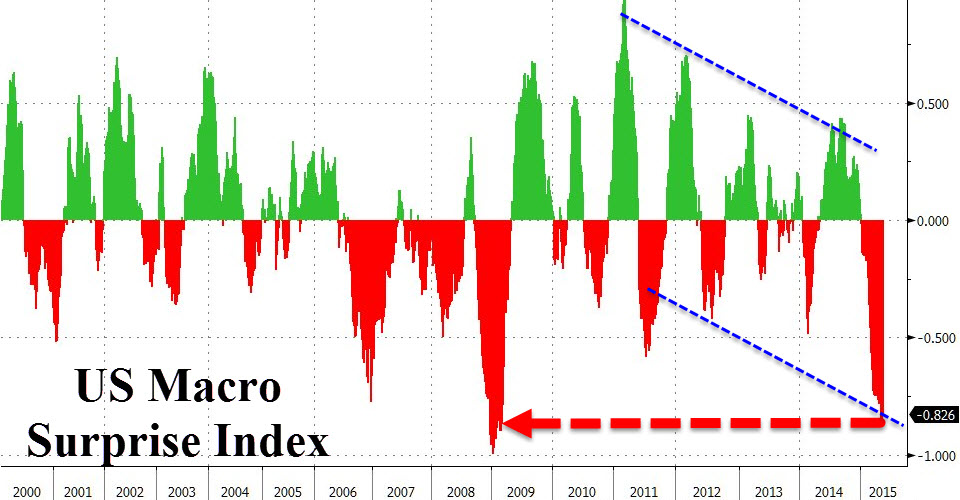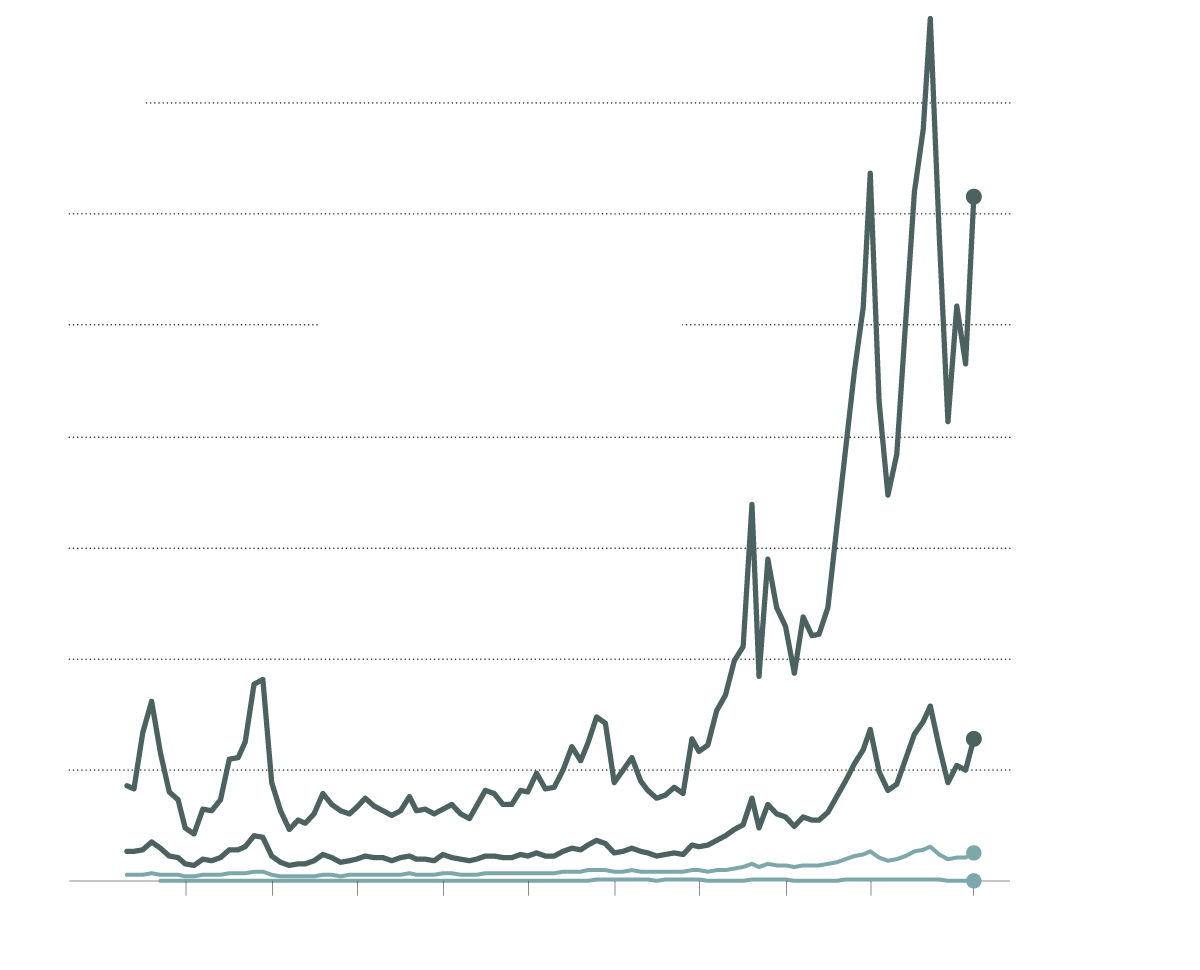This past week has been much the same as the last couple of months - boring. It has been more interesting trying to count carpet fibers in my office than watching the markets.
However, there has been some excitement in domestic bond yields that have SURGED over the last couple of weeks. Well, as I discussed earlier this week, its a surge alright, you just need a magnifying glass to actually see it.
"The chart below is a 40-year history of the US 10 Year T-Note interest rate. The dashed red lines denote the long-term downtrend in interest rates."

"The recent SURGE in interest rates is hardly noticeable when put into a long-term perspective. After rates dropped to their second lowest level in history of 1.68%, only exceeded by the "great debt ceiling default crisis of 2012" level of 1.46%, the recent bounce to 2.26% was expected"
There also has been the divergence in economic data, some good, but mostly not. This has been good for the stock market as "bad news" means the Federal Reserve has no reason to raise rates in the near future. This is particularly the case with first quarter's GDP printing negative and second quarter's falling below 1%.
This leaves investors in a precarious position of remaining invested as the financial markets levitate away from underlying economic realities. In fact, as recently pointed out by Tyler Durden at Zerohedge, the deviation of the markets from the economic data is one of the largest since the turn of the century.

For now, however, we wait for the market to decide its next action. Will be a resumption of the "bull run" as the vast majority expect or will the contrarian side of the markets finally prevail? I think we will have that answer very soon.
While we await that answer, I have compiled a this week's reading list to include a smattering of articles on everything from the markets, to investing, to the Fed to the economy.
1) Bond Rout Puts Bears On Wrong Side Of Fed by Simon Kennedy via Bloomberg Business
"Keeping monetary policy loose is still justified to economists at JPMorgan Chase & Co. They reckon global economic growth of 1.2 percent in the first quarter was the second weakest outside of a recession in the past 25 years and worldwide inflation of 0.4 percent was the lowest.
Torsten Slok, chief international economist at Deutsche Bank AG, told clients that "the QE trade is not over" and yields should soon reverse their rise once markets stabilize.
'What we have seen in markets over the past two weeks has been triggered by fear and not by a change in the outlook for economic fundamentals,' said Slok. 'I continue to see U.S. rates under downward pressure as a result of money printing abroad.'"
Read Also: 4 Charts Why The Fed Not Likely To Raise Rates This Year via Streettalklive
2) High Share of Part-Time Workers Explain Weak Wage Growth by Kathleen Madigan via WSJ
"One possible explanation is that more companies have restructured their staffing to focus on part-time workers. Because of that, there is slightly more slack in the labor markets than the jobless rate indicates. And these part-timers have less bargaining power to negotiate higher wages.
To be sure, most of the jobs created in this expansion (as reported in the household survey) are full-time positions. But part-time spots, less than 35 hours a week, now account for a larger share of total employment than they did before the recession. That's true for total part-time workers and for part-time workers who would prefer a full-time position."

3) The Federal Reserve's Asset Bubble Machine by Ruchir Sharma via WSJ Opinion
"At Morgan Stanley Investment Management, we have analyzed data going back two centuries and found that until the past decade no major central bank had ever before set short-term interest rates at zero, even in periods of deflation.
To critics who warn that pumping trillions of dollars into the economy in a short period is bound to drive up inflation, today's central bankers point to stagnant consumer prices and say, 'Look, Ma, no inflation.' But this ignores the fact that when money is nominally free, strange things happen, and today record-low rates are fueling an unprecedented bout of inflation across asset prices."
4) Even Among The Richest, Fortunes Diverge by Annie Lowrey via NY Times
"It found that in 2012, the average household in the bottom 90 percent of the income distribution earned about $30,997. For the average household in the top 1 percent, the figure is $1,264,065, and for the top 0.1 percent, about $6,373,782.
Put another way, our 0.1 percent household made about 206 times, and our 1 percent household about 41 times, what our average household did. That gap has yawned over time. In 1990, for instance, the same multiples were 87 and 21. In 1980, they were 47 and 14."

5) The Cardinal Sin - Missing Out by Charlie Bilello via Pension Partners
(Note: This could also be titled: Why you will be hammered during the next downturn)
'The greatest fear in the investment management industry is not what one might expect. It is not losing money but the fear of not making enough money when the market is moving relentlessly higher. This "fear of missing out" strikes terror into the heart of portfolio managers as clients will simply not tolerate it; it is the cardinal sin of the business.
The thinking was explained to me as follows. Lose money when the markets are going down and everyone else is suffering and you'll be just fine. But fail to capture maximum upside during a raging bull market and you'll soon be out of a job."
Read Also: Bulls Should Not Expect Help From The Fed by Cam Hui via Humble Student Of The Markets
OTHER INTERESTING STUFF
A Dozen Things I Learned From Julian Robertson About Investing via 25iq
"A colleague of Robertson once said: 'When he is convinced that he is right, Julian bets the farm.' George Soros and Stanley Druckenmiller are similar. Big mispriced bets don't appear very often and when they do people like Julian Robertson bet big. This is not what he has called a 'gun slinging' approach, but rather a patient approach which seeks bets with odds that are substantially in his favor. Research and critical analysis are critical for Julian Robertson. Being patient, disciplined and yet aggressive is a rare combination and Robertson has proven he has each of these qualities."
Moore's Law Turns 50 by Thomas L. Friedman via WSJ Opinion
"But what an exponential it's been. In introducing the evening, Intel (NASDAQ:INTC)'s C.E.O., Brian Krzanich summarized where Moore's Law has taken us. If you took Intel's first generation microchip, the 1971 4004, and the latest chip Intel has on the market today, the fifth-generation Core i5 processor, he said, you can see the power of Moore's Law at work: Intel's latest chip offers 3,500 times more performance, is 90,000 times more energy efficient and about 60,000 times lower cost."
"If you think nobody cares if you're alive, try missing a couple of car payments." – Earl Wilson
